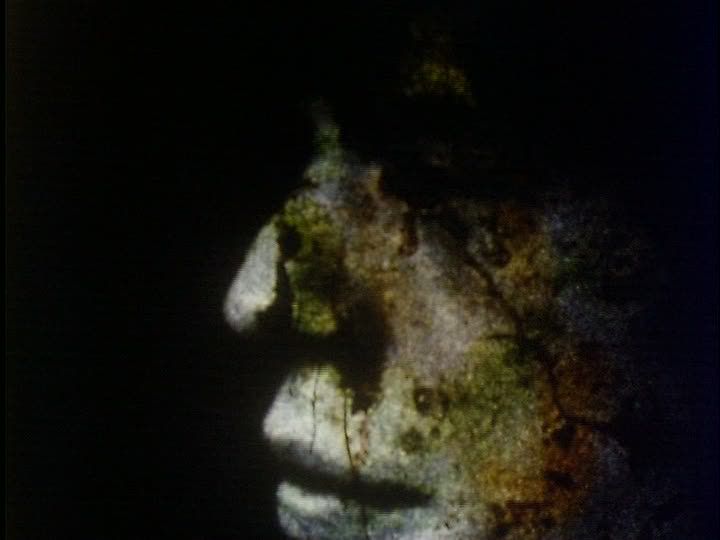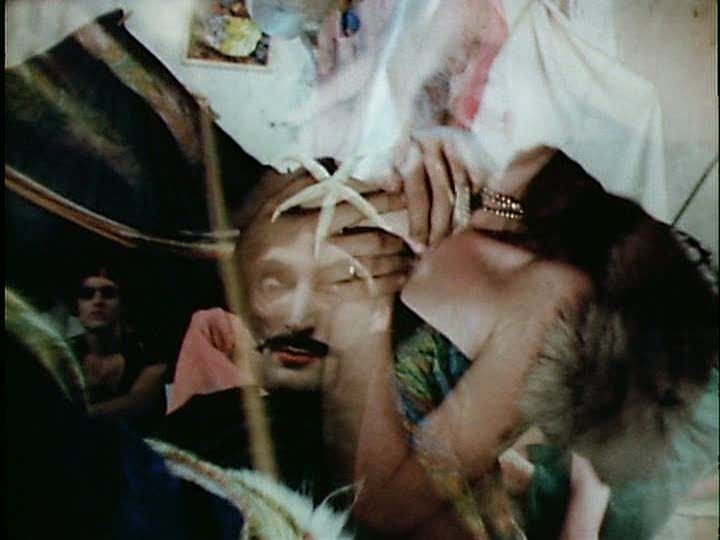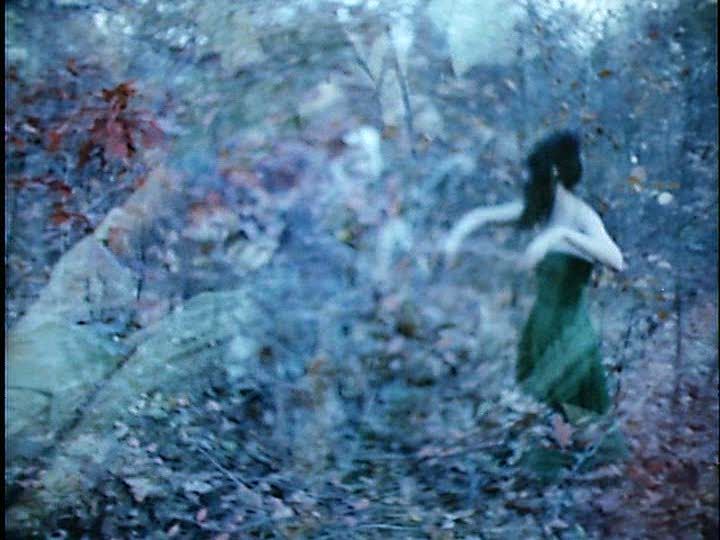

Aleph, the only film made by Beat artist Wallace Berman, is a frantic collage that represents, in a brisk 9 minutes, a kind of hyper-speed gestalt vision of the 1960s and all that that wild, tumultuous decade represented. Berman, a poet and artist, worked on Aleph as a kind of private journal, continuously altering it and adding to it, collaging together the images that fascinated him and subjecting them to a process of degradation, layering and frantic editing so that each image is merely a momentary flash before the eyes, flickering into motion and then vanishing within the deluge of visual stimuli that Berman stitches together for this film. He apparently uses newsreels, still photos, home movies, advertising cutouts, and any other visual material he can get his hands on, building upon these varied foundations a powerful document of 60s culture.
The haunting beauty of this film arises from the impression that it is constantly on the verge of falling apart, or that perhaps Berman assembled it from exhumed materials encrusted with the wear of the ages. The film crackles and pulses with the signs of film degradation: burns, brown-hued scars and scratches, black lines shimmering across the frame. To this, Berman adds his own defacements, layering on additional colors and superimposing text — flashing across the frame too fast to read, mostly composed of Hebrew writing and other glyphs anyways — on top of the rapidly moving stream of images. These images originated from a variety of sources, ranging from private, intimate footage to the public appearances of celebrities, radicals and world figures. Bob Dylan, Mick Jagger, the Pope, pulp magazines, softcore porn, home movies, Alice in Wonderland, a snatched shot of a movie theater marquee playing It's a Mad, Mad, Mad, Mad World. The 60s vibrate and pulse through Berman's film, in every frame: all the chic 60s girls, lounging around in long dresses or in the nude, practicing free love; the radicals reading books with delicate wire glasses looking out-of-place on their hard faces; Dylan looking young and baby-faced the way he did on the cover of his eponymous first album; Jagger, as always, stretching those rubbery lips to sing or shout; sober, suited politicians in clusters, caught from above so their bald spots show. All of this is contained by Berman's film, appearing and then disappearing, returning in subtle rhythms.
The film has something of the aesthetic of an old photograph, decaying and rotting with age. Figures and faces seem to emerge from an encrustation of rust, and the images are frequently textured, thickly layered with paint and markings and scratches across the emulsion of the film. The sheer variety of the images, and the pace of the editing, gives the film a surging forward momentum, a vibrancy that captures the sense of freedom and enthusiasm running through this era. And yet at the same time the whole thing seems already retrospective, an artifact of the past, assembled throughout the peak of the 60s and yet already with a built-in nostalgia in its half-obscured images, a sense of looking back at a moment already lost. There is, in this film, a nostalgia for a time that had not even yet ended when this film was made, as though Berman already sensed the import of this era and the ways in which it would someday be eulogized and remembered. It is thus by turns a haunting film, a joyous one, an aggressive one, cycling through moods and impressions as quickly as its images flicker by.
This impression is enhanced by the film's lack of a proper soundtrack. It is totally silent, though when showing it privately, which was pretty much the only way Berman ever did show it, he often accompanied it with a random record. The film is more or less a very radical home movie, intended for home viewing, constantly subject to change, always being reworked or paired with whatever music was at hand. It is a film very much alive with the circumstances of its own construction, and with the spirit of the era captured so memorably in its torrent of images.


Ron Rice's Chumlum is one of those films in which the conditions of its construction are integral to the experience of watching it. It is a record of a cadre of creative people having fun on camera, playing dress-up, dancing, flirting, lazing around. The film's cast gathers together a roster of figures from the Warhol Factory and the underground arts and film scenes in New York: Beverly Grant, Francis Francine, Mario Montez (star of Warhol's infamous Mario Banana), Gerard Malanga, Joel Markman and filmmaker Jack Smith, whose film Normal Love was the inspiration for Chumlum (Rice made the short while working with Smith to assemble props for the latter's film). This ensemble cast is nothing unusual for the era, a sign of the film's emergence from this prolific and fertile period in 60s New York when seemingly everyone was working with everyone else.
Rice uses these familiar faces and personae as fodder, as a kind of foundation from which he builds his densely layered compositions. The use of multiple overlays and superimpositions means that no image, no performer, stands on its own, no image exists in isolation. Instead, multiple images are used for their textural properties: a burst of color here, a fluid movement there, a flicker of reflected light there, and somewhere in the background the dull blue flicker of a nighttime horror scene, a mummy shambling after its intended victim through the somber dark. Furthermore, Rice frequently uses semi-transparent materials within the individual images, adding to the sense of fragile, gauzy overlays. The actors wrap themselves in shawls and sheets, the thin material acting in much the same way as Rice's superimpositions, rendering multiple layers within the image, creating compositions where one is always looking through something. A woven cot, with its honeycomb of empty spaces between its threads, is overlaid with a thin fabric sheet, and then incorporated as one onion-skin layer within Rice's dense overload.

This film is dazzling and sensual, reveling in the gender-ambiguous piles of flesh and translucent fabrics. At times, the frame becomes so cluttered, so dense with multiple layers, that it's nearly impossible to separate out the constituent parts from one another. The individual images are often blurred and swirled together into collages of stray limbs and colorful patterns, chaotic and beautiful pile-ups that completely confuse things. It's disorienting and reduces the human form to one more abstract component in Rice's hodge-podge compositions, which blend textures and exotic elements, throwing together Eastern garments and decorative flourishes of various origins. This catholicism is also reflected in the clanging, bell-like music by Angus MacLise, the onetime Velvet Underground drummer who left the group before they ever recorded their first album, and whose Oriental-influenced music, with its elements of repetition and minimalism, provides just the right soundtrack to Rice's fantasia: stripped-down and destabilizing, with a sound that just barely hints at exotic lands and foreign musics in its ringing tonalities.
Chumlum is a viscerally exciting, visually stimulating short that uses the formal properties of layering and multiple exposures to create a film in which multiple narratives seem to be happening at once, in which pirates and Middle Eastern belly dancers coexist within the same space as New York bohemians and cross-dressers. Rice co-opts the imagery and props of various genres and traditions, all of it accumulating into a multi-layered pastiche that suggests all stories without actually telling any of them.








0Awesome Comments!